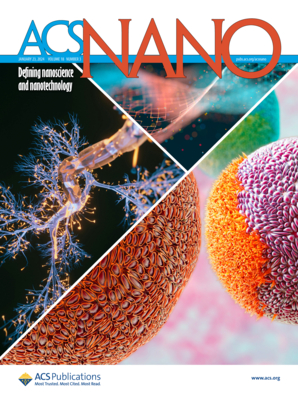Toehold-Based CRISPR-dCas9 Transcriptional Activation Platform for Spatiotemporally Controllable Gene Therapy in Tumor and Diabetic Mouse Models
IF 15.8
1区 材料科学
Q1 CHEMISTRY, MULTIDISCIPLINARY
引用次数: 0
Abstract
The CRISPR-Cas system has been extensively employed as a genome editing tool with the dCas9-based transcriptional activation system emerging as a particularly promising approach for gene editing in the treatment of diseases at the gene level. Nevertheless, the challenge of achieving effective spatiotemporal control of the transcriptional activation system of dCas9 has thus far restricted its broader application. In this study, we present an miRNA-responsive CRISPR-dCas9 transcriptional activation (mCTA) system. This system is capable of responding specifically to exogenous and endogenous miRNAs in mammalian cells and enables the specific imaging of miRNAs during neural development or in the deep tissues of mice. Furthermore, the replacement of downstream functional genes with DTA has been demonstrated to result in the effective apoptosis of tumor cells and inhibition of xenografted tumor growth in mice. Finally, in a diabetic mouse model, the m122CTA system was shown to reduce the blood glucose in diabetic mice via the activation of PDX-1 gene. Our work provides an effective platform for miRNA imaging and gene therapy via spatiotemporal control of gene regulation.

CRISPR-Cas 系统已被广泛用作基因组编辑工具,而基于 dCas9 的转录激活系统则成为在基因水平上治疗疾病的一种特别有前途的基因编辑方法。然而,迄今为止,实现对 dCas9 转录激活系统有效时空控制的挑战限制了其更广泛的应用。在这项研究中,我们提出了一种 miRNA 响应型 CRISPR-dCas9 转录激活(mCTA)系统。该系统能够特异性地响应哺乳动物细胞中的外源和内源 miRNA,并能对神经发育过程中或小鼠深部组织中的 miRNA 进行特异性成像。此外,用 DTA 替代下游功能基因已被证明能有效凋亡肿瘤细胞并抑制小鼠异种移植肿瘤的生长。最后,在糖尿病小鼠模型中,m122CTA 系统通过激活 PDX-1 基因,降低了糖尿病小鼠的血糖。我们的工作为 miRNA 成像和通过时空控制基因调控进行基因治疗提供了一个有效的平台。
本文章由计算机程序翻译,如有差异,请以英文原文为准。
求助全文
约1分钟内获得全文
求助全文
来源期刊

ACS Nano
工程技术-材料科学:综合
CiteScore
26.00
自引率
4.10%
发文量
1627
审稿时长
1.7 months
期刊介绍:
ACS Nano, published monthly, serves as an international forum for comprehensive articles on nanoscience and nanotechnology research at the intersections of chemistry, biology, materials science, physics, and engineering. The journal fosters communication among scientists in these communities, facilitating collaboration, new research opportunities, and advancements through discoveries. ACS Nano covers synthesis, assembly, characterization, theory, and simulation of nanostructures, nanobiotechnology, nanofabrication, methods and tools for nanoscience and nanotechnology, and self- and directed-assembly. Alongside original research articles, it offers thorough reviews, perspectives on cutting-edge research, and discussions envisioning the future of nanoscience and nanotechnology.
 求助内容:
求助内容: 应助结果提醒方式:
应助结果提醒方式:


